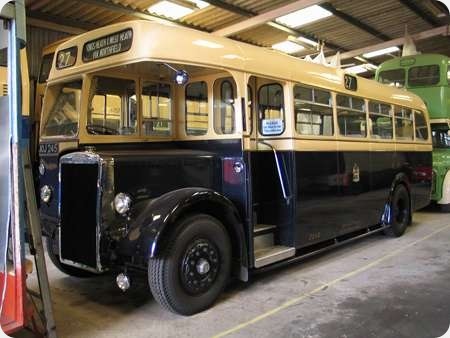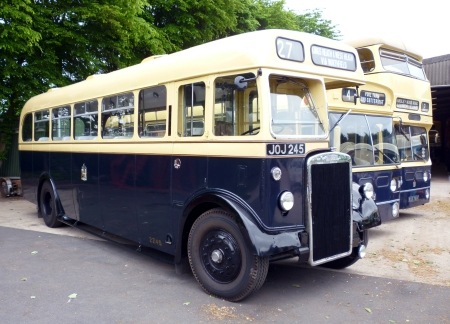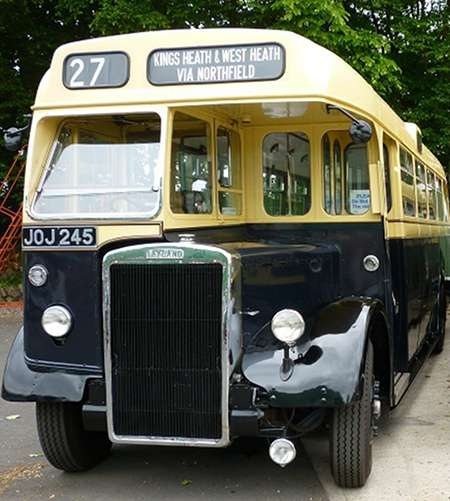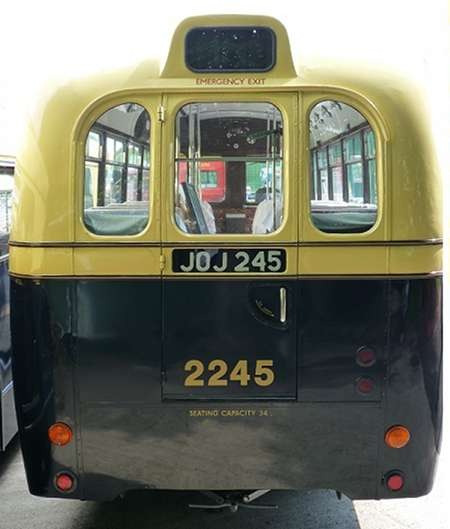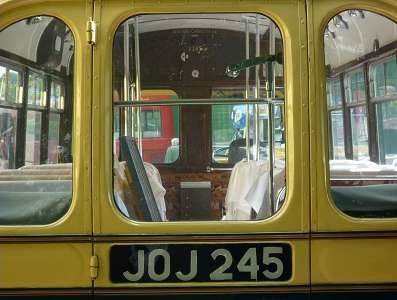Birmingham City – Leyland Tiger – JOJ 245 – 2245
Birmingham City Transport
1950
Leyland Tiger PS2
Weymann B34F
This superb combination of Leyland Tiger and classic Weymann single-deck body is further enhanced by the application of Birmingham City livery. 2245 is well-maintained by the Transport Museum, Wythall. Chassis number is 495582, body number M4624 and seating is B34F.
Photograph and Copy contributed by Les Dickinson
05/07/15 – 07:32
Don’t you just mourn the demise of municipal transport when you see vehicles like this, with their distinctive livery and civic coats of arms. And in the case of many of them, including Birmingham, never letting an advert blemish the bodywork!
Chris Hebbron
05/07/15 – 11:54
I agree wholeheartedly Chris H, and the beautiful vehicle in the picture is a exceptional example of "how things should be." I readily admit, in my dotage, to be horrified at many of today’s presentations of meaningless mobile artwork which totally destroy what could have been acceptable shapes of modern buses. For example, the latest craze from FirstBus in this area, as if the insipid white, lilac and purple wasn’t bad enough, is to plaster the top decks around the destination displays with gaudy purple offerings for "The Pulse" – services of better than ten minutes frequency. The effect of this gripping marketing wheeze is to render the electronic destinations and route numbers virtually unreadable, especially in bright sunlight. The cost ?? – I imagine that no-one dare publicise that figure and,far from increasing patronage, is simply a further annoyance to already disinterested passengers.
Chris Youhill
05/07/15 – 11:55
To be fair, Chris, even Birmingham had succumbed to the exterior adverts when I was there in my student days of the mid sixties, although I never saw a single decker in service with the ‘feature’, only the doubles.
Pete Davies
06/07/15 – 06:38
I agree entirely about the advertising. Bournemouth was another municipal operator that did not carry advertising. Worst of all today are those advertisements and so-called route branding that are actually carried over the windows – and I do like to be able to look out of the bus!
David Wragg
06/07/15 – 06:39
Birmingham’s civic pride would not countenance the idea of advertising on its buses for many years – although most of the trams carried them throughout their lives, resulting in a fair bit of extra revenue for the Transport Department.
However, once the trams were gone by 1953 this source of revenue was lost and the Transport Committee were reluctantly forced to accept advertising on the buses. After all, the next time the Department applied for a fares increase they might well have been refused on the grounds that while the buses had no adverts there was now an untapped source of income that the Transport Department should use first!
Larry B
06/07/15 – 06:40
Very fair comment Pete, and I suppose that "we outsiders" can’t condemn operators for making some revenue from commercial advertisements, those in the traditional tidy formations on double deckers particularly. My strong objection nowadays is to ludicrous extremes of expensive "in house" blurb plastered all over windows inside and out on already ghastly "liveries", and of no interest whatsoever to the travelling public who, to use those apt but well worn words, "only want a comfortable bus on time at a reasonable fare."
Chris Youhill
06/07/15 – 08:35
When the first of these ‘dot matrix’ adverts appeared on a Southampton Citybus vehicle, it was allegedly possible to see out, but not in – rather like the net curtains of old. Even outward vision is impaired, however. As for route branding, well, it works in some places, but not in many. The attitude seems to be one of ‘if it’s marked for the 3 and it appears on the 27, then its an advert for the folk along the 27 about the highlights of the 3’. Balderdash!
Pete Davies
06/07/15 – 11:07
It is possible from a passenger’s point of view to see through those Contravision adverts when they are looking out at 90 degrees to the glass, though there is a significant darkening effect.
However they can be a real problem and a safety hazard from the driver’s point of view. When emerging from a junction of the 90 degree variety the driver will look through the door windows to check for oncoming traffic, but there are very many others – especially on the routes that I drive – which are at an acute angle where the driver has to lean forward, twist round and look back through the first nearside window. This can already be difficult enough if there are standing passengers (because they always congregate at the front), the nearside luggage rack is stacked with pushchairs, or if the company has thoughtfully decided on siting a side route number/destination box right in your line of view, but looking through Contravision at 45 degrees you can see nothing at all. Those responsible for specifying it will not have even considered this aspect.
I also can not fathom the mentality of bus company managers who specify ‘stylish’ new vehicles with extremely large, heavy and expensive windows, then mask half their area with promotional vinyls.
John Stringer
07/07/15 – 06:54
Very valid comments John, and I’m very surprised that the folk from VOSA haven’t banned Contravision (Controversial vision?) on safety grounds for the reasons you cite. One wonders what the union view is on this too. I read recently that many women boarding buses in the evenings or at night do not like Contravision at all, as they cannot see if any potential nuisance passengers are on board before they get on. Also, many older people out at night are wary for the same reason. So much for certain operators’ duty of care to their passengers and staff.
Brendan Smith
07/07/15 – 06:55
This bus was one of nine hired by PMT at various times during 1969 and 1970 to cover vehicle shortages. Lovely buses, exceptional condition, well powered …… but pretty useless on services normally operated by 72 seat Atlanteans!! Although any bus was better than no bus at all.
Ian Wild
15/07/15 – 05:55
Having been brought up with BCT buses, although these Leylands, nor the AEC ever came my way, I do remember the furore that arose when it was announced that adverts were going to be carried. Even the bus crews themselves were against the idea and of course worst was to come, when the rear platform numbers already diminished from large shaded gold into a smaller gold style were lifted up to just under the registration number ‘to make room for further advertising. But whichever local bus company you favoured, all of them Birmingham, West Bromwich, Walsall (what an interesting fleet) and Wolverhampton all produced buses and crews that compared well with any in England..and then of course there was the ‘daddy’ and in their minds the leader in the field Midland Red. How uninteresting now when apart from the body shape, the only way of knowing what chassis/power unit is involved is by looking at the steering wheel badge. Why is at that the modern bus fleets don’t want anyone to know the make of bus or body?
R. G. Davis
15/07/15 – 15:27
You’re so right with your last point, RG, in that such coyness is in stark contrast to past chassis/body builders!
Chris Hebbron
16/07/15 – 05:35
To me, the (non) distinguishing feature about modern buses is the fact that they all look, sound and perform the same, with a total absence of individuality. Thus anonymity is entirely apt.
Roger Cox
17/07/15 – 12:35
RG Davis asks why we don’t know the make of bus or body these days….?
I wonder if it was always a bit like this…?
Until Fleetlines (when they went to the other extreme) you usually only knew a Daimler CVD by its fluted radiator or later, possibly a discreet radiator badge, or a Leyland by perhaps its hubs, especially if the fleet had plonked its own name on the radiator instead of theirs. This hardly improved with Atlanteans with just the badge on the back. Older Bristols had tiny little badges, although Guys had an easy name to promote. Did any bodybuilders have anything more than a little plate or transfer- except perhaps CH Roe with those lovely transmission covers?
Am I wrong? I suspect that proud municipalities didn’t want makers promoting themselves.
You do now see Alexander-Dennis or Wright on buses- but who makes what, especially which screaming engine- they all sound like old diesel buzz-boxes anyway, desperately hunting for a gear!
Joe
18/07/15 – 08:18
While I agree with all the previous comments re Advertising and Identification badges, oh and Joe’s observation about the "screamers", we lost touch with this beautiful machine that started the post! So, having followed the restoration of 2245 (and many others) at Wythall here are some additional views from frequent visits.
Nigel Edwards
Quick links to the - Comments Page - Contact Page - Home Page
Comments - Please note: The comments facility is not currently available. Please see the home page for updates.
Please Note if you want to send a photograph with your comment please use the Contact Page by clicking here or send as an attachment via email.
